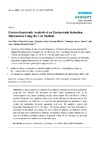Please use this identifier to cite or link to this item:
https://accedacris.ulpgc.es/jspui/handle/10553/44328
| Title: | Electro-quasistatic analysis of an electrostatic induction micromotor using the cell method | Authors: | Monzón-Verona, José Miguel Santana-Martín, Francisco Jorge Garcia-Alonso Montoya, Santiago Montiel-Nelson, Juan Antonio |
UNESCO Clasification: | 3306 Ingeniería y tecnología eléctricas | Keywords: | Micromotor Electrostatic Induction Cell method Direct finite formulation |
Issue Date: | 2010 | Publisher: | 1424-8220 | Journal: | Sensors | Abstract: | An electro-quasistatic analysis of an induction micromotor has been realized by using the Cell Method. We employed the direct Finite Formulation (FF) of the electromagnetic laws, hence, avoiding a further discretization. The Cell Method (CM) is used for solving the field equations at the entire domain (2D space) of the micromotor. We have reformulated the field laws in a direct FF and analyzed physical quantities to make explicit the relationship between magnitudes and laws. We applied a primal-dual barycentric discretization of the 2D space. The electric potential has been calculated on each node of the primal mesh using CM. For verification purpose, an analytical electric potential equation is introduced as reference. In frequency domain, results demonstrate the error in calculating potential quantity is neglected (<3‰). In time domain, the potential value in transient state tends to the steady state value. | URI: | https://accedacris.ulpgc.es/handle/10553/44328 | ISSN: | 1424-8220 | DOI: | 10.3390/s101009102 | Source: | Sensors (Switzerland)[ISSN 1424-8220],v. 10, p. 9102-9117 |
| Appears in Collections: | Artículos |
Show full item record
SCOPUSTM
Citations
4
checked on Jun 8, 2025
WEB OF SCIENCETM
Citations
4
checked on Jun 8, 2025
Page view(s)
103
checked on Mar 9, 2024
Download(s)
240
checked on Mar 9, 2024
Google ScholarTM
Check
Altmetric
Share
Export metadata
Items in accedaCRIS are protected by copyright, with all rights reserved, unless otherwise indicated.
